Related Research Articles

A transcontinental railroad or transcontinental railway is contiguous railroad trackage, that crosses a continental land mass and has terminals at different oceans or continental borders. Such networks can be via the tracks of either a single railroad or over those owned or controlled by multiple railway companies along a continuous route. Although Europe is crisscrossed by railways, the railroads within Europe are usually not considered transcontinental, with the possible exception of the historic Orient Express. Transcontinental railroads helped open up interior regions of continents not previously colonized to exploration and settlement that would not otherwise have been feasible. In many cases they also formed the backbones of cross-country passenger and freight transportation networks. Many of them continue to have an important role in freight transportation and some like the Trans-Siberian Railway even have passenger trains going from one end to the other.

Jason Gould was an American railroad magnate and financial speculator who founded the Gould business dynasty. He is generally identified as one of the robber barons of the Gilded Age. His sharp and often unscrupulous business practices made him one of the wealthiest men of the late nineteenth century. Gould was an unpopular figure during his life and remains controversial.
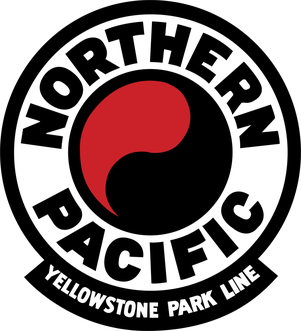
The Northern Pacific Railway was a transcontinental railroad that operated across the northern tier of the western United States, from Minnesota to the Pacific Northwest. It was approved by Congress in 1864 and given nearly 40 million acres of land grants, which it used to raise money in Europe for construction.
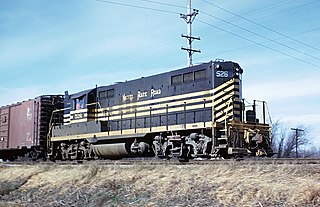
The New York, Chicago and St. Louis Railroad, abbreviated NYC&St.L, was a railroad that operated in the mid-central United States. Commonly referred to as the "Nickel Plate Road", the railroad served parts of the states of New York, Pennsylvania, Ohio, Indiana, Illinois, and Missouri. Its primary connections occurred in Buffalo, Chicago, Cincinnati, Cleveland, Indianapolis, St. Louis, and Toledo.
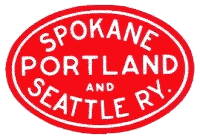
The Spokane, Portland & Seattle Railway was a railroad in the northwest United States. Incorporated in 1905, it was a joint venture by the Great Northern Railway and the Northern Pacific Railway to build a railroad along the north bank of the Columbia River. The railroad later built or acquired other routes in Oregon. The SP&S was merged into the Burlington Northern in March, 1970. Remnants of the line are currently operated by BNSF Railway and the Portland and Western Railroad.

The Western Maryland Railway was an American Class I railroad (1852–1983) that operated in Maryland, West Virginia, and Pennsylvania. It was primarily a coal hauling and freight railroad, with a small passenger train operation.
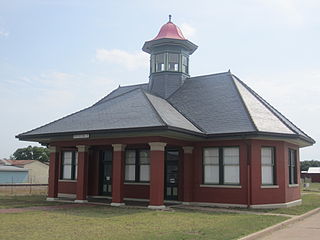
The International – Great Northern Railroad (I&GN) was a railroad that operated in the U.S. state of Texas. It was created on September 30, 1873, when the International Railroad and the Houston and Great Northern Railroad merged. The railroad was officially incorporated as the International & Great Northern Railroad Company.
Stuart R. Knott was the fourth president of Kansas City Southern Railway.
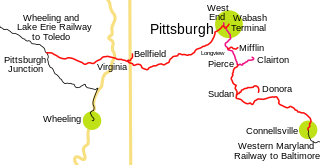
The Pittsburgh and West Virginia Railway was a railroad in the Pittsburgh, Pennsylvania, and Wheeling, West Virginia, areas. Originally built as the Wabash Pittsburgh Terminal Railway, a Pittsburgh extension of George J. Gould's Wabash Railroad, the venture entered receivership in 1908 and the line was cut loose. An extension completed in 1931 connected it to the Western Maryland Railway at Connellsville, Pennsylvania, forming part of the Alphabet Route, a coalition of independent lines between the Northeastern United States and the Midwest. It was leased by the Norfolk and Western Railway in 1964 in conjunction with the N&W acquiring several other sections of the former Alphabet Route, but was leased to the new spinoff Wheeling and Lake Erie Railway in 1990, just months before the N&W was merged into the Norfolk Southern Railway.
The E.H. Harriman Award was an annual award presented to American railroad companies in recognition for outstanding safety achievements.

The Terminal Railroad Association of St. Louis is a Class III switching and terminal railroad that handles traffic in the St. Louis metropolitan area. It is co-owned by five of the six Class I railroads that reach the city: BNSF, Canadian National, CSX, Norfolk Southern and Union Pacific. The railroad also serves Amtrak and Canadian Pacific Kansas City.
The following is a brief history of the North American rail system, mainly through major changes to Class I railroads, the largest class by operating revenue.
The following is a brief history of the North American rail system, mainly through major changes to Class I railroads, the largest class by operating revenue.
The Fuller Syndicate was a group of American financiers that invested in railroads in the late 19th and early 20th centuries.

The Wabash Pittsburgh Terminal was a railroad station located in Pittsburgh, Pennsylvania, United States. Constructed in 1903 and opened on April 13, 1904, the 11 floor Beaux-Arts domed 197 foot tall terminal was designed by Theodore Carl Link and cost George Jay Gould $800,000. Floors 1 through 3 contained ticketing, passenger waiting areas and some retail with floors 4 and above serving hundreds of offices of Gould's Wabash Railway Corporation. The terminal lasted only four years as a Wabash Railroad terminal when the Wabash Pittsburgh Terminal Railway entered receivership on May 29, 1908. The Wabash would go on to lose both this railway and end affiliation with the Wheeling and Lake Erie Railway. The terminal continued to service passenger traffic until October 31, 1931, but survived beyond that as an office building and freight-only facility. Upon its repurposing, the building also lost its 11th-floor cupola. The adjacent freight warehouse was closed after two successive fires on March 6, and March 22, 1946 destroyed most of the infrastructure. The station was announced for demolition on July 5, 1953 to make way for the Gateway Center complex. Demolition started on October 5, 1953 and was completed in early 1954.

The Wabash Railroad was a Class I railroad that operated in the mid-central United States. It served a large area, including track in the states of Ohio, Indiana, Illinois, Iowa, Michigan, and Missouri and the province of Ontario. Its primary connections included Chicago, Illinois; Kansas City, Missouri; Detroit, Michigan; Buffalo, New York; St. Louis, Missouri; and Toledo, Ohio.

Charles Elliott Perkins was an American businessman and president of the Chicago, Burlington and Quincy Railroad. He was so well respected that historian Richard Overton wrote, "From the time that Charles Elliott Perkins became vice president of the Chicago, Burlington and Quincy [1876] ... until he resigned as president in 1901, he was the Burlington."

The history of the Union Pacific Railroad stretches from 1862 to the present. For operations of the current railroad, see Union Pacific Railroad; for the holding company that owns the current railroad, see Union Pacific Corporation.
Streetcars in Redlands transported people across the city and region from 1889 until 1936. The city's network of street railways peaked around 1908 before the patchwork of separate companies was consolidated under the Pacific Electric.
The Gould family is a wealthy American family that came to prominence in the late 19th century. The family's fortune was primarily earned through a railroad empire built by Jason "Jay" Gould, a notorious "robber baron" during the Gilded Age. At its height, this network comprised the Denver & Rio Grande, Missouri Pacific, Wheeling & Lake Erie, Wabash, Texas Pacific, Western Maryland and International-Great Northern railroads among others.
References
- 1 2 Treese, Lorett (2003). "Section Seven. Pittsburgh Area". Railroads of Pennsylvania: Fragments of the Past in the Keystone Landscape. Mechanicsburg, PA: Stackpole Books. p. 229. ISBN 978-0-8117-2622-1 . Retrieved September 6, 2009– via Google Books.
- 1 2 Schafer, Mike (2000). More Classic American Railroads. Osceola, WI: MBI Publishing Co. p. 141. ISBN 978-0-7603-0758-8. OCLC 44089438.
- ↑ "George Gould's Plans". The Houston Post. August 18, 1901. p. 20 – via Newspapers.com.

- ↑ "Harriman Has A Through Line". Marysville Evening Democrat. September 20, 1906. p. 7 – via Newspapers.com.

- ↑ "Harriman and Gould Begin Strenuous Race". The San Francisco Call. June 30, 1907. p. 43 – via Newspapers.com.

- ↑ "What The Deal Is to St. Louis". St. Louis Post-Dispatch. November 11, 1906. p. 39 – via Newspapers.com.

- ↑ "Confirms Report of Harriman's Big Deal". San Francisco Chronicle. September 18, 1906. p. 1 – via Newspapers.com.

- ↑ "Western Pacific Threatened By Deal". Oroville Daily Register. September 19, 1906. p. 1 – via Newspapers.com.

- ↑ "Harriman Lines Rivaled By The Gould Holdings". El Paso Herald. November 25, 1905. p. 5 – via Newspapers.com.

- ↑ "Ocean To Ocean By 1908". Deseret News. March 18, 1904. p. 10 – via Newspapers.com.

- ↑ "Peaceful Trade Conquest". Omaha Daily Bee. August 12, 1908. p. 5 – via Newspapers.com.

- ↑ "Final Steps in New York". The Baltimore Sun. June 9, 1908. p. 1 – via Newspapers.com.

- 1 2 3 4 5 "Is Rockefeller The Backer". Stockton Daily Evening Record. August 28, 1903. p. 2 – via Newspapers.com.

- ↑ "Rockefeller Will Soon Have No Rival". The Indianapolis News. August 12, 1903. p. 6 – via Newspapers.com.

- ↑ "Oust Goulds from M.P." The Washington Post. March 10, 1915. p. 10 – via Newspapers.com.

- 1 2 "Goulds Are Ousted From Mo. P. Control". Daily Arkansas Gazette. March 10, 1915. p. 8 – via Newspapers.com.

- 1 2 3 4 "Old Jay Gould's Grip Is Pried Loose at Last". The Pittsburgh Press. February 26, 1911. p. 55 – via Newspapers.com.

- 1 2 "Goulds To The Pacific". The Baltimore Sun. November 23, 1902. p. 14 – via Newspapers.com.

- ↑ "Railroad News - Only 150 Miles To Complete Gould Transcontinental Line". The Topeka Daily Herald . March 14, 1906. p. 2 – via Newspapers.com.

- ↑ "Link in Gould Transcontinental System". The Raleigh Herald. June 9, 1910. p. 3 – via Newspapers.com.

- ↑ "Valley and Central Important Factors in Railway 'War'". The Morning Call. Allentown, PA. May 4, 1929. p. 4 – via Newspapers.com.

- ↑ "Rockefeller Said to Control W. M. R. R." The Baltimore Sun. May 20, 1908. p. 1 – via Newspapers.com.
